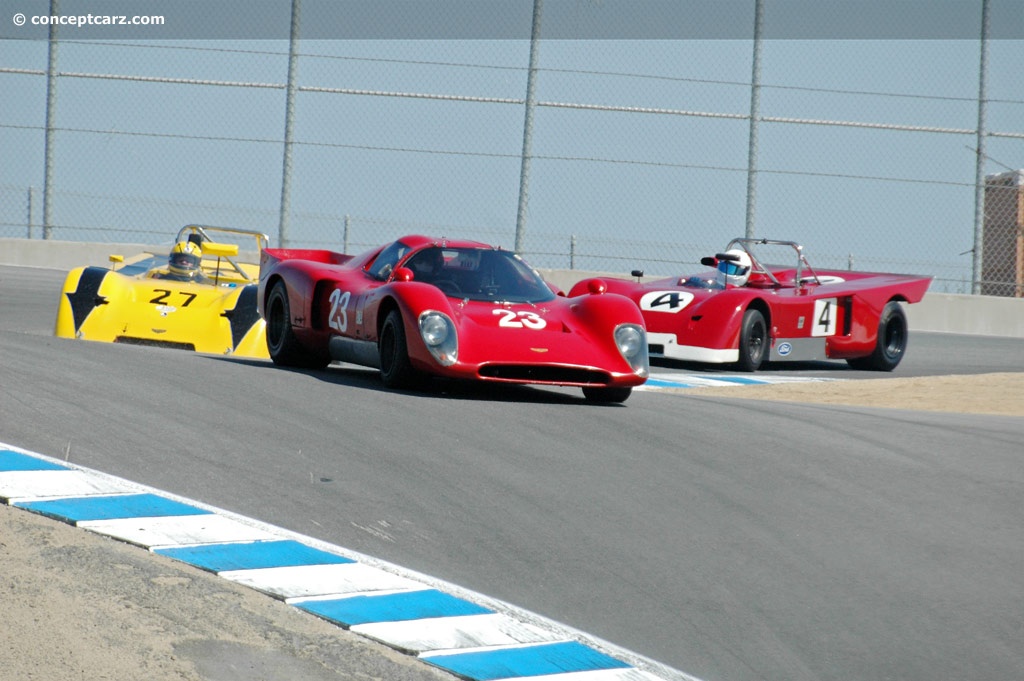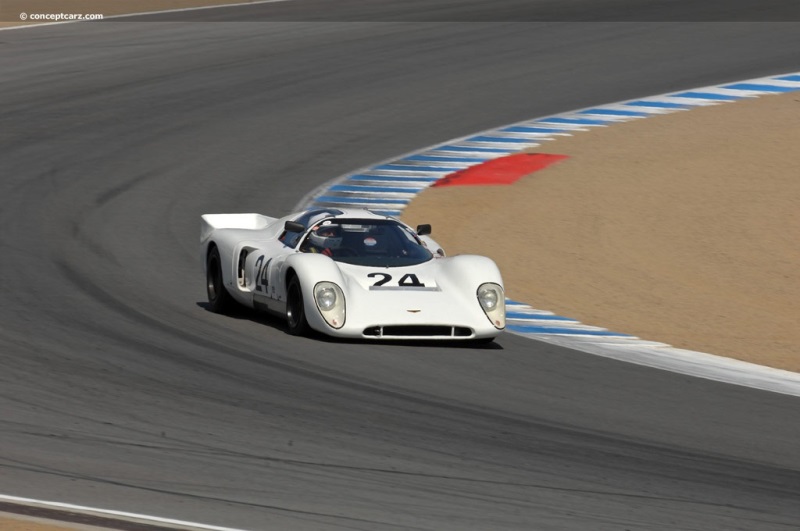Nigel Bennett created the Chevron B1 as his personal GT race car and it proved rather successful, winning its first race, a British Clubman event on July 2nd, 1965. Bennett's next design was called the B8, and it too was successful. A variety of modifications and evolutions brought about his next design, the B16. 
Coupe
Chassis #: DBE16
View info and historyThe Chevron B16 used a spaceframe chassis reinforced with steel and aluminum panels to create a semi-monocoque center section. The tubular frames in the front and back carried the suspension and the mid-engine driveline. The front used parallel wishbones while the rear suspension had a pair of wishbones and upper links. The rear tubular spaceframe was sturdy enough to carry a variety of engines, most used to contest the under 2-liter sportscar competition. The Chevron B8 was powered by a 2-liter BMW four-cylinder engine with a single cam and two-valve head. By the time of the B16's introduction, the BMW powerplant had been fully developed and could not be improved upon further. Bennet initially planned to commission Cosworth or Weslake to modify the BMW engine even further by adopting a new head on the engine. Although costly, it would have kept the engine competitive for a few more seasons. Bennett ultimately decided to stick with the Ford engine after Cosworth began developing the 'FVC' version of the 1.6-liter 'FVA' Formula 2 engine. The engine displaced a mere 1,760cc but was much more powerful than the BMW engine it replaced. The elegant fiberglass body was conceived by Bennett and refined by stylist Jim Clark of Specialised Mouldings, Chevron's contractor to build the wafer-thin B16 bodies. Brian Redman was the development driver for the B16 (using the older BMW engine), offering his knowledge and experience to finely hewn it for competition. 
Coupe
Chassis #: 23Although many designers and manufacturers used the most exotic materials and construction techniques available, Bennett's Chevrolet B16 used tried-and-true practices of the time and was reliable, sold, fast, competitive, and adaptable to different configurations. Brian Redman was tasked with driving the B16 in its inaugural debut at the Nürburgring 500km race on September 7th, 1969. The car was equipped with a Cosworth FVA 1,600cc Formula engine, which was quick enough to claim the pole position by over five seconds. Redman piloted the Chevron to the front of the pack throughout the race and went on to win. The earlier B16 suffered from understeer but this was resolved on later examples with rear spoilers that balanced aerodynamic rear downforce at speed to offset the nose's front downforce. During the production lifespan of the Chevron B16, just 23 examples were built. Homologation requirements for 'Group 5' GT racing required a minimum of 25 examples, and despite producing just 23 examples, the car was cleared for racing. 
Coupe
Chassis #: 23Along with the Cosworth engine, customers also fitted the BMW with the BMW four and a Mazda rotary engine. Steve McQueen used three examples in his movie LeMans.At the 1970 European 2-liter Championship season opener, Lola shocked the racing community by bringing their new all-new T210. With open coachwork, it was lighter by 70 kg than the B16 coupe. Redman and John Burton battled against Jo Bonnier and the T210 all season, and Redman was able to score much-needed points throughout the season, including a victory at the first round at Paul Ricard. The winner of the championship came down to the final round, with Lola, Chevron, and Abarth all vying for the necessary points to crown them champions. Redman was seeking every advantage and was able to convince Bennett to build a B16 spyder using the shape of the Porsche 908/3 that he had driven to victory in the Targa Florio that year. The B16 Spyder that followed used the mechanical components of the B16 coupe, with an entirely new body. In this guise, Redman raced the car to disappointing results at the Nürburgring 500 km, but was able to earn a victory at Spa, securing the championship for Chevrolet.
Coupe
Chassis #: B16-71-36
Auction entries : 1For the following season, Chevron introduced the production version of the B16 Spyder called the B19.
by Daniel Vaughan | Feb 2020

Coupe
Chassis #: DBE16
View info and history

Coupe
Chassis #: 23

Coupe
Chassis #: 23

Coupe
Chassis #: B16-71-36
Auction entries : 1
by Daniel Vaughan | Feb 2020
Related Reading : Chevron B16 History
Derek Bennett was the individual responsible with the formation of Chevron Cars Ltd. He was a brilliant engineer, mostly self-taught, and had a talent for modifying, repairing, and sculpting automobiles. Near the close of the 1950s he began working in a shop in North England where he quickly developed a name for himself. When he was not working at the track, he could often be seen at nearby tracks....
Continue Reading >>
Continue Reading >>
Chevron
Similar Vehicles
1969 Chevron B16 Vehicle Profiles
Recent Vehicle Additions
Related Automotive News

The Mid-Engine Corvette at the Amelia Island Concours d'Elegance
With the recent introduction of the Chevrolet C8 Corvette, the first production mid-engine Corvette sports car, the 2020 Amelia Island Concours dElegance took the opportunity to tell the story of the mid-engine Corvette legacy. The canvas...

WORLD-FIRST DISPLAY OF ALL SEVEN REMAINING LOTUS 49S LINING-UP AT AUTOSPORT INTERNATIONAL
Autosport International to host display featuring all seven remaining Lotus type 49 cars thanks to their owners from around the world
Celebrations at Autosport International to mark 50 years since this pioneering F1 car first raced
To this day, th...
RRDC VOTES IN 37 NEW MEMBERS FOR 2013
HILLIARD, Ohio (Nov. 7, 2013) - Thirty-seven race-car drivers and motorsports professionals have been voted into the Road Racing Drivers Club in 2013. The group includes 13 Regular Members from the open-wheel and sports-car racing ranks, 20 Associate...

1964 Nurburgring 1000 Kilometers: Survive for One Last Victory
During the late 1950s, Richie Ginther would begin a relationship with John von Neumann and this partnership would result in one of the most dominant periods of American sportscar racing in which Ginther and Porsche would be virtually unbeatable. Nearly...

1967 Can-Am Road America: The Beginning of the 'Bruce and Denny Show'
While Formula One will be forever considered the pinnacle of motorsport, from a period between 1966 and 1986 there existed a series that would likely be the closest to anything goes as any motor racing series could truly get. Based upon the FIA Group...

























